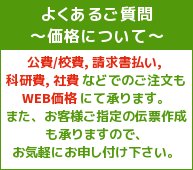|
|
Chemical Dynamics in Condensed Phases, 2 Revised edition
出版済み 3-5週間でお届けいたします。
Title: Chemical Dynamics in Condensed Phases, 2 Revised edition
Subtitle: Relaxation, Transfer, and Reactions in Condensed Molecular Systems
Series: Oxford Graduate Texts
Author: Nitzan, Prof Abraham (Professor of Chemistry and Donner Professor of Physical Science, Professor of Chemistry and Donner Professor of Physical Science, University of Pennsylvania)
Publisher: Oxford University Pr.
ISBN: 9780192857187
Cover: HARDCOVER
Date: 2024年06月
|
|
|
Amazon Pay
Amazon Payでは、「Amazon.co.jp」アカウントに登録されているクレジットカード情報や配送先情報などを利用して、そのまま決済することができます。
「Amazon.co.jp」アカウントに登録された配送先とクレジットカード情報は安全に保管されています。クレジットカード情報が弊社に渡ることはございません。
高度なセキュリティシステムにより安心してお買い物をお楽しみいただけます。
発送の準備ができましたら決済させていただきます。
※1回のご注文で複数冊ご注文された場合、入荷状況によっては分割納品が発生する場合がございます。
このような場合の決済につきましては、完納時に一括決済をさせていただきます。 請求書払い(法人のお客様)
法人のお客様は請求書払い(後払い)でのご注文を承ります。
初回ご注文時に弊社規定の与信審査を行わせていただく場合がございます。
納品の際に見積書、納品書、請求書を同封致しますので、弊社の取引銀行口座にご入金下さい。
弊社の取引銀行口座番号は、請求書に記載されています。
誠に恐れ入りますが、振込手数料はお客様のご負担とさせていただきます。
配送先情報の「備考欄」に請求書の宛名、必要な書類と枚数、書類作成に関するご要望などをご入力ください。
商品の送付先は原則としてお客様のご所属先法人宛とさせていただきます。 クレジットカード決済
発送の準備ができましたら、ご指定のカードより決済させていただきます。
クレジットカードの決済につきましては、GMOイプシロン株式会社の「イプシロン決済サービス」を利用しています。
高度なセキュリティシステムにより安心してお買い物をお楽しみいただけます。
※1回のご注文で複数冊ご注文された場合、入荷状況によっては分割納品が発生する場合がございます。
このような場合のクレジットカードの決済につきましては、完納時に一括決済をさせていただきます。
※不正利用防止の為、ご注文者様名と同じ名義のクレジットカードにて決済をおこなってください。
※ご注文情報等に不備や不審な点がある場合はご注文者様の本人確認(電話確認等)をお願いする場合がございます。また、不正利用を防止するためにご注文をキャンセルさせていただく場合がございます。
|
|
ゆうメール、ゆうパックまたは宅配便
【配送方法】
ご注文時にご指定頂いたお届け先に弊社指定のゆうメール、一般小包郵便物(ゆうパック)、または宅配便にてお送り致します。また、営業担当員が直接お届けすることもございます。
【送料】
送料は全国一律 500円となります。
ただし、1回のご注文金額の合計が4,500円(税込)以上の場合は、送料無料となります。
【海外発送】
弊社では海外発送は承っておりません。
We don’t ship overseas.
|
|
|

| 販売業者 |
株式会社ニュートリノ東京 会社概要 |
| 運営統括責任者名 |
代表取締役社長 小黒 総一郎 |
| 郵便番号 |
1820024 |
| 住所 |
東京都調布市布田1-44-3 高橋ビル |
| 商品代金以外の料金の説明 |
販売価格とは別に配送料、振込手数料がかかる場合もございます。 |
| 申込有効期限 |
<ニュートリノ商品購入確認メール(自動配信)>を弊社にて送信以降、原則としてキャンセルはお受けしておりません。
また、弊社よりお申込みをキャンセルすることはございませんが、出版状況や在庫などは常に変動しており、状況によってはキャンセルさせていただくことがございます。
|
| 不良品 |
注文とは異なる商品が届いた場合や乱丁、落丁のみ返品・交換を承ります。その際は、到着から7日以内にメール、電話、ファックスにてご連絡願います。また、その他のお客様のご都合による商品の返品・交換はお受けできません。 |
| 販売数量 |
各商品ページにてご確認ください。 |
| 引渡し時期 |
ご注文商品は原則として海外の出版社からのお取り寄せとなります。既刊本につきましては3〜5週間、未刊本につきましては刊行後2〜3週間程となります。一時品切れ、入荷の遅延、出版の遅延などでご注文商品の納期に遅れが見込まれる場合は、ご登録のメールアドレスにお知らせのメールをお送り致します。 |
| お支払い方法 |
請求書払い(法人のお客様)
クレジットカード
Amazon Pay
|
| お支払い期限 |
請求書払い(法人のお客様)によるご注文について
納品の際に見積書、納品書、請求書を同封致しますので、銀行または郵便局の弊社の口座にご送金ください。
※銀行または郵便局の弊社口座番号は、請求書に記載されています。
ご注文ページの備考欄にて、請求書の宛名、必要書類の枚数、書類作成に関するご要望などをご入力ください。 |
| 返品期限 |
(返品特約) 弊社からの<ニュートリノ商品購入確認メール(自動配信)>送信直後のキャンセル以外は承っておりません。
注文とは異なる商品が届いた場合や乱丁、落丁のみ返品・交換を承ります。その際は、到着から7日以内にメール、電話、ファックスにてご連絡願います。また、その他のお客様のご都合による商品の返品・交換はお受けできません。 |
| 返品送料 |
注文とは異なる商品が届いた場合や乱丁、落丁による返品・交換に該当する場合は当方で負担いたします。 |
| 資格・免許 |
全省庁統一資格業者コード : 0000192808
適格請求書発行事業者登録番号:T4012401035495 |
| 屋号またはサービス名 |
ニュートリノ東京 ECサイト |
| 電話番号 |
042-484-5550 Non Japanese speaker - Please E-mail: E-mail(In English Only) |
| 公開メールアドレス |
info@neutrino.co.jp |
| ホームページアドレス |
https://neutrino.shop-pro.jp/ |
|
|

























